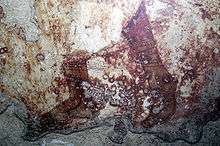Calceus

The Calceus (pl. calcei: cf Latin calx "ankle") was a mid-weight, outdoor walking "shoe-boot", worn in ancient Rome. It was flat-soled, usually hobnailed and entirely covered the foot and ankle, up to the lower shin. It was secured with crossed thongs or laces.[1] Lighter than the openwork caligae favoured by the Roman military, calcei were considered a distinctive part of Rome's public, civilian "national dress", which centered on the toga as an exclusive mark of Roman male citizenship. The equivalent for women citizens was the stola, which could be worn with white or coloured calcei in various decorative styles. The calcei of most ordinary citizens were probably a natural brown tanned leather. The equestrian class had its own distinctive form of calceus, with crescent-shaped buckles. Male citizens of senatorial rank and office, including certain priesthoods, were expected to wear a red-bordered toga praetexta and red calcei (s. mulleus calceus) when engaged in their public duties. The combination of toga and calcei was impressive, but also hot and uncomfortable; the Roman poet Martial claims that in their leisure time, and more relaxed surroundings of rural life, hardly anyone used it.[2] Even in the city, some high-ranking citizens wore light, Greek-style sandals, rather than calcei, to "go with the crowd".[3][4]
See also
References
- ↑ Goldman, N., in Sebesta, Judith Lynn, and Bonfante, Larissa, editors, The World of Roman Costume: Wisconsin Studies in Classics, The University of Wisconsin Press, 1994, pp. 105-113
- ↑ William Smith et al., editors (1890) A Dictionary of Greek and Roman Antiquities, London: William Wayte. G. E. Marindin entry for calceus
- ↑ Shumba, L., in Edmondson, J. C., and Keith, A., (Editors), Roman Dress and the Fabrics of Roman Culture, University of Toronto Press, 2008, p. 191
- ↑ Edmonson, J. C., in Edmondson, J. C., and Keith, A., (Editors), Roman Dress and the Fabrics of Roman Culture, University of Toronto Press, 2008, pp. 45-47 and note 75